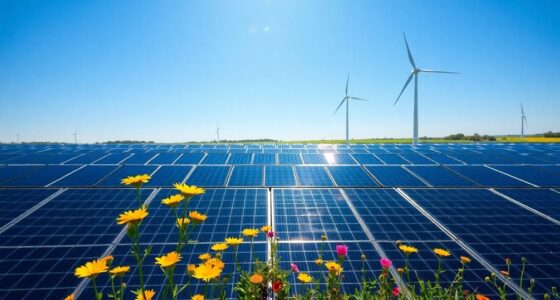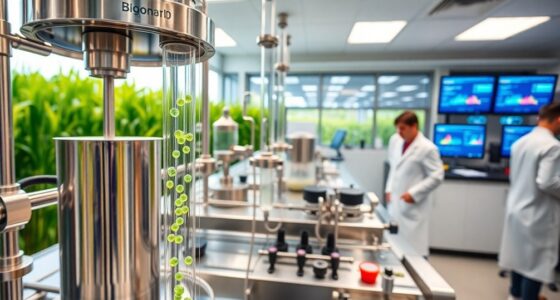Green energy storage solutions are crucial for harnessing renewable energy effectively. Technologies like pumped hydro energy storage, lithium-ion batteries, and thermal energy storage help balance supply and demand. Flow batteries and compressed air energy storage offer innovative options for energy management, while hydrogen fuel cells provide clean power. Supercapacitors excel in fast energy bursts, and ice storage manages cooling needs efficiently. There’s much more to explore about these exciting advancements in energy storage that can enhance sustainability and efficiency.
Key Takeaways
- Renewable energy storage solutions like lithium-ion batteries and flow batteries enhance energy efficiency and support the integration of solar and wind power.
- Pumped Hydro Energy Storage (PHES) effectively balances supply and demand, utilizing excess energy to store water for later electricity generation.
- Thermal Energy Storage (TES) systems reduce peak energy demand by storing heat or cold for later use, contributing to cost savings and efficiency.
- Hydrogen fuel cells offer a clean energy transition option, producing electricity while emitting only water and heat as byproducts.
- Supercapacitors provide rapid energy bursts for high-power applications, enhancing grid stability while being environmentally friendly and reducing waste.
Pumped Hydro Energy Storage

Pumped Hydro Energy Storage (PHES) is one of the most effective methods for storing energy, particularly when it comes to balancing supply and demand. PHES works by pumping water from a lower reservoir to an upper one using excess energy, then releasing it to generate electricity when you need it. This method is a prime example of how renewable energy solutions can be effectively utilized to enhance energy efficiency.
With a round-trip efficiency of 70% to 80%, it’s cost-effective for peak demand periods. The system requires significant elevation changes, typically involving two reservoirs and reversible turbines. Additionally, PHES can stabilize electrical network frequency and provide reserve generation capabilities during high demand, while also supporting renewable energy integration in the grid. This innovative solution complements other renewable energy sources, such as solar energy, enhancing overall energy resilience.
Though the initial investment is high, PHES offers low operational costs and long facility lifetimes, making it economical over time. Plus, it supports renewable energy integration while minimizing environmental impact, ensuring a cleaner energy future.
Lithium-Ion Battery Storage

As the demand for efficient energy storage solutions grows, lithium-ion batteries have emerged as a leading technology that meets diverse needs across various applications.
Their high energy density allows you to store more energy in a compact form, making them ideal for portable electronics like smartphones and laptops. Additionally, the absence of state income tax on certain retirement income, such as that from IRA withdrawals in states like Washington, mirrors the efficiency and effectiveness of lithium-ion batteries in maximizing available resources. Furthermore, the technology behind lithium-ion batteries continues to evolve, paralleling advancements in heat pump performance, which enhances their utility in renewable energy systems. In fact, their design incorporates principles similar to those found in low light office plants, which thrive in challenging conditions.
With a long cycle life, they provide consistent energy storage, essential for electric vehicles and renewable energy systems. Additionally, their high round-trip efficiency minimizes energy losses during storage and usage, further enhancing their appeal.
Fast charging and discharging capabilities help smooth out energy fluctuations, while high efficiency minimizes energy loss. Plus, they require low maintenance compared to traditional batteries.
As you explore energy storage options, lithium-ion technology stands out for its versatility and reliability in powering today’s devices and future innovations.
Thermal Energy Storage (TES)
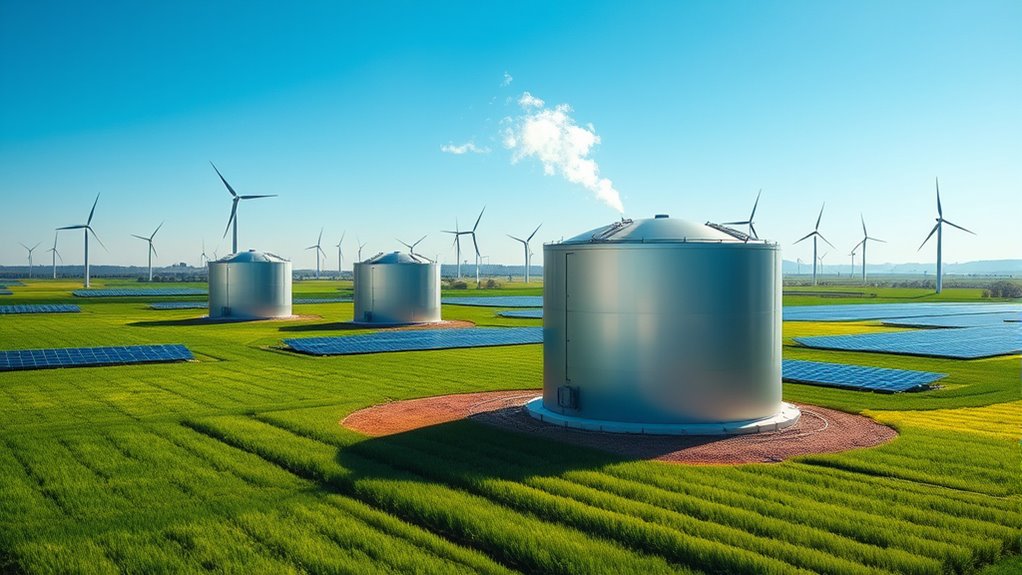
While traditional energy storage methods often focus on electricity, thermal energy storage (TES) offers a unique approach by storing heat or cold for later use.
You can apply TES in various sectors, from residential heating and cooling to industrial processes and electricity generation. By storing excess thermal energy, it helps reduce peak demand and lower energy costs, making it a cost-efficient solution. Additionally, commercial grade heat pumps enhance the effectiveness of TES by providing efficient heating and cooling solutions. Modern heat pumps are designed with quieter operation in mind, contributing to a more comfortable environment when utilizing TES.
The global market for TES is projected to exceed USD 91.6 billion by 2032, driven by the need for renewable energy integration. With categories like sensible heat storage and thermochemical storage, TES enhances energy reliability and efficiency. Regular maintenance of systems utilizing TES can significantly improve their performance and efficiency, similar to heat pump maintenance practices.
Embracing TES allows you to optimize energy use while contributing to sustainability and decarbonization efforts.
Flow Battery Storage

Flow battery storage has paved the way for innovative solutions like flow battery storage, which offers a different approach to energy management.
Flow batteries consist of two large tanks holding liquid electrolytes, allowing you to control power and energy capacity independently. As electrolytes are pumped through porous electrodes, they undergo chemical reactions that store or release energy. Understanding the importance of strategic planning can further enhance the effectiveness of energy management systems. Additionally, reflecting on past mistakes in energy management strategies can lead to more effective decision-making and improved outcomes.
Flow batteries utilize liquid electrolytes in large tanks, enabling independent control of power and energy capacity through chemical reactions.
This modular design means you can easily scale capacity by adjusting tank sizes. With long-term storage capabilities and non-flammable electrolytes, flow batteries are safe and durable, lasting decades with minimal performance loss. Proper sealing mechanisms contribute to the overall efficiency of energy management systems.
As the market for flow batteries grows—projected to reach $1.1 billion by 2029—ongoing research into new chemistries will enhance affordability and efficiency, making them a compelling choice for renewable energy integration.
Compressed Air Energy Storage (CAES)

Compressed Air Energy Storage (CAES) offers a practical solution for managing the fluctuations of renewable energy sources like wind and solar. This technology compresses air and stores it underground in caverns or tanks for later use.
CAES addresses intermittency by converting electrical energy into potential energy during the compression stage. When energy’s needed, compressed air is released, heated, and expanded through a turbine to generate electricity. As of late 2012, three large-scale CAES facilities exist globally, showcasing its implementation and potential. Solar battery banks are also crucial for effective energy storage, allowing integration with various renewable sources. Additionally, CAES systems can benefit from gold investments to help safeguard against market volatility and inflation. Furthermore, hydrogen fuel cells can complement CAES by providing a clean energy source during peak demand.
With energy storage capacities ranging from a few megawatts to several gigawatts and efficiency levels between 60% and 80%, CAES is a viable option. Advanced systems even aim to minimize fossil fuel use by reusing heat generated during compression, making it a more sustainable choice for the future of energy storage.
Emerging Energy Storage Technologies
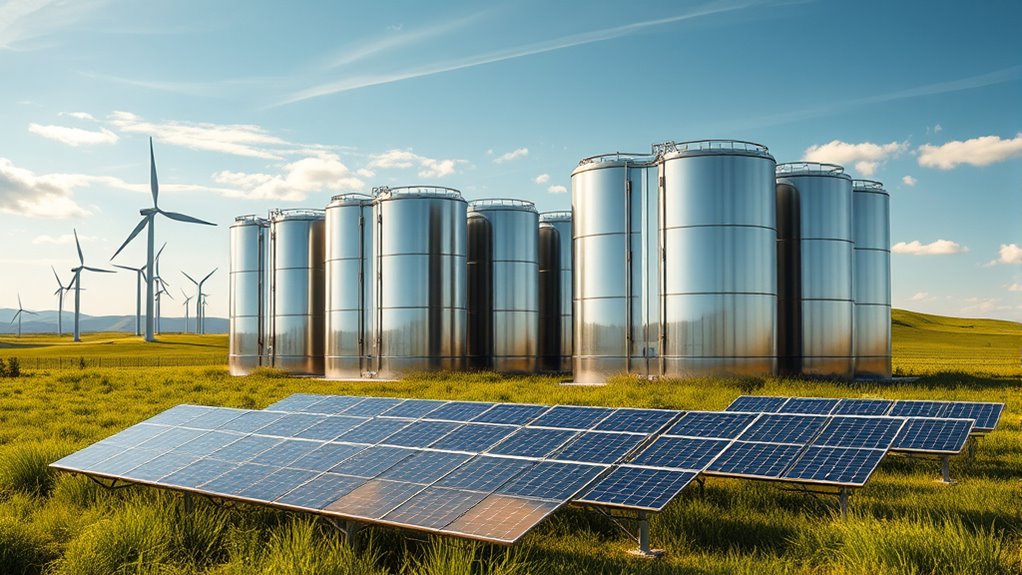
As the demand for renewable energy grows, innovative energy storage technologies are emerging to meet the challenges of intermittency and reliability.
While lithium-ion batteries currently dominate the market, alternatives like sodium-ion, redox flow, and solid-state batteries are gaining attention for their cost-effectiveness and safety. Global energy storage market growth is expected to reach over 2 TWh by 2030, further driving the need for these alternative technologies. Tokenization of energy assets could enhance liquidity and investment in these emerging storage solutions. Additionally, color accuracy is crucial in the development of battery management systems to ensure optimal performance. The rise of renewable energy technologies is also pushing the boundaries of energy storage solutions to support a sustainable energy infrastructure.
Lithium-ion batteries lead the market, but sodium-ion, redox flow, and solid-state alternatives are emerging for their cost and safety benefits.
You’ll also find zinc-hybrid and iron-air batteries addressing mid-duration storage needs.
Meanwhile, gravity storage systems, like those from Energy Vault, leverage mechanical methods to provide scalable, long-duration solutions.
Plus, thermal energy storage using advanced materials enhances efficiency for balancing energy output.
With the global energy storage market expected to grow six-fold by 2030, the diversification of these technologies is essential for a sustainable energy future.
Hydrogen Fuel Cells
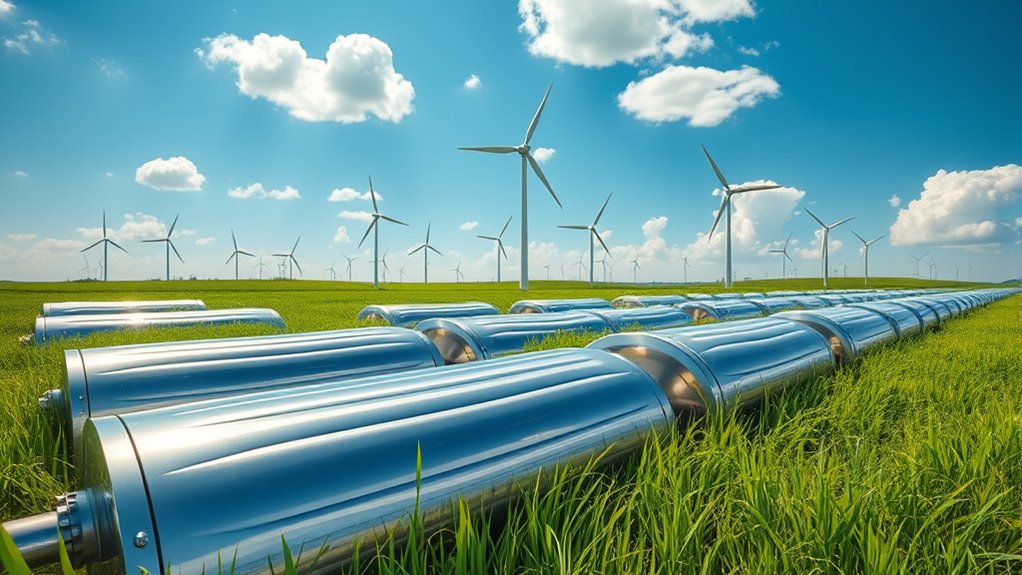
While hydrogen fuel cells are often overlooked, they play a crucial role in the transition to clean energy.
These cells, particularly Proton Exchange Membrane (PEMFC) and Solid Oxide Fuel Cells (SOFC), offer high efficiency and produce only water and heat as byproducts. Additionally, indexed annuities can provide a balance between risk and reward, making them appealing to investors looking to support sustainable technologies. Incorporating omega-3 content from various sources can enhance overall energy efficiency in related technologies. Furthermore, energy-efficient models can significantly impact the adoption of hydrogen fuel cells by lowering operational costs.
You’ll find they provide a reliable power source, essential for data centers aiming for sustainability.
With hydrogen being generated from natural gas, biogas, or water electrolysis, you can tap into flexible production methods.
Plus, on-site hydrogen production can cut transport costs.
As technology advances, expect improvements in efficiency and cost, making hydrogen fuel cells a viable long-term solution for energy storage and decarbonization efforts.
Their potential is immense, aligning with global sustainability goals, especially as hydrogen production methods diversify to enhance energy security.
Supercapacitors
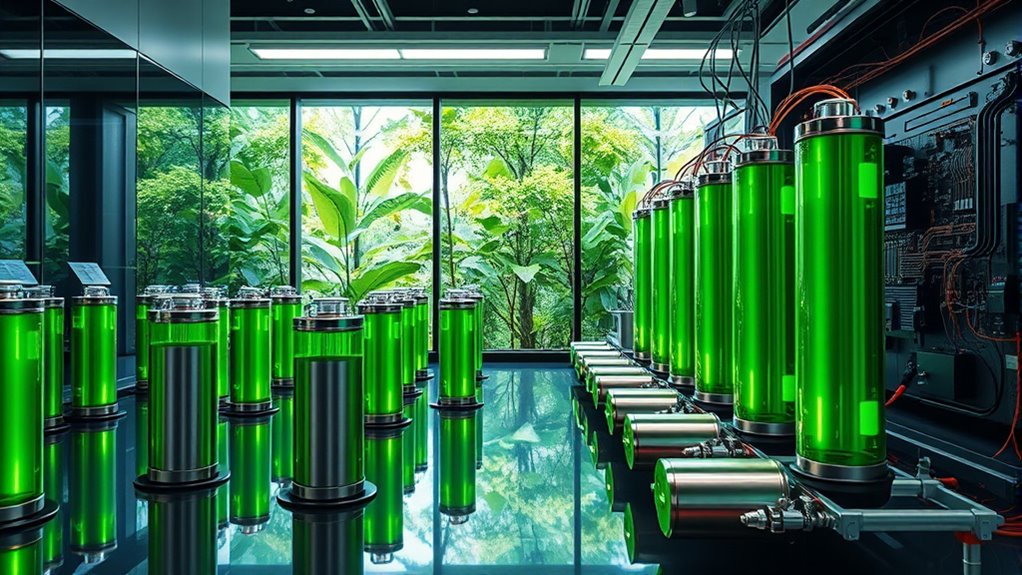
Hydrogen fuel cells pave the way for various innovative energy solutions, including supercapacitors. These devices can be fully charged in seconds, making them perfect for applications that need quick energy bursts. With a long operational lifespan, supercapacitors endure hundreds of thousands of charge-discharge cycles, outlasting traditional batteries. Additionally, their long operational lifespan leads to cost savings on replacements over time. Although their energy density is lower, they excel in high-power applications, such as smoothing out the variable power output from renewable sources and enhancing grid stability. Geothermal heat pumps, for instance, utilize renewable energy sources to significantly reduce greenhouse gas emissions. Environmentally, supercapacitors help reduce waste and greenhouse gas emissions. You’ll find various types, like electric double-layer capacitors and pseudocapacitors, utilizing innovative materials like curved graphene. Their fast charge-discharge speed and durability make them a sustainable choice for your energy storage needs. Furthermore, these supercapacitors can be integrated with AI algorithms to optimize energy management systems in smart grids.
Ice and Cold Storage
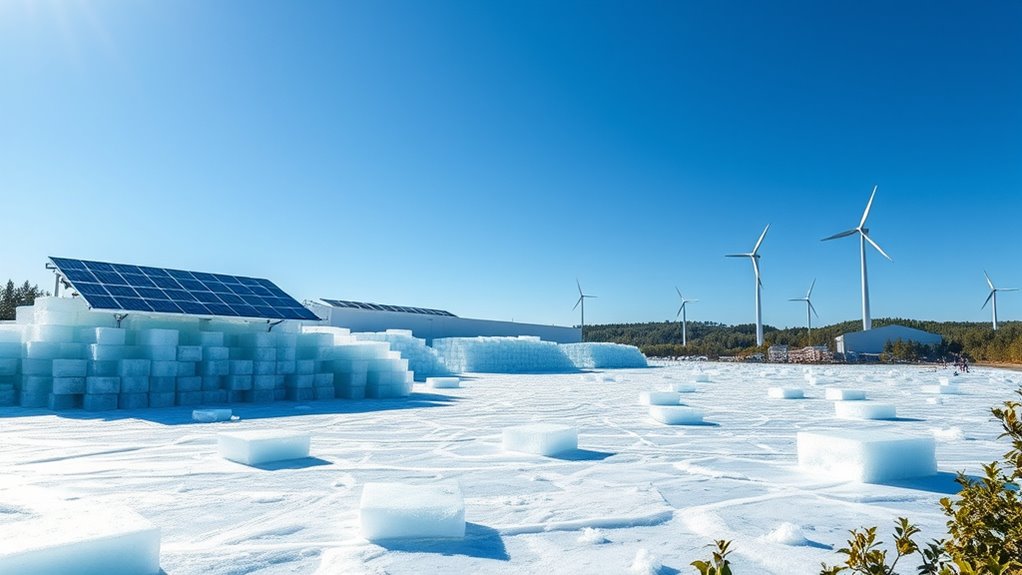
When it comes to energy storage, ice and cold storage solutions offer a smart way to manage peak cooling demands. You can store significant energy—one metric ton of water holds about 93 kWh—helping cut peak electrical usage. By using smaller chillers, typically 40-50% less than conventional ones, you enhance operational efficiency. These systems are perfect for campus-wide air conditioning and can shift cooling loads to off-peak hours, saving you money. Modular designs like sp.ICE optimize space and efficiency while boosting heat transfer. Not only do they power district cooling networks, but they also provide flexibility regardless of renewable energy fluctuations. Additionally, ice storage systems let you tackle cooling needs sustainably and effectively. Embracing ice storage technology lets you tackle cooling needs sustainably and effectively.
Frequently Asked Questions
How Do Energy Storage Solutions Impact Grid Stability?
Energy storage solutions play a vital role in maintaining grid stability. They help you balance supply and demand by storing excess energy during low-demand times and releasing it when demand peaks.
What Are the Environmental Impacts of Energy Storage Technologies?
When considering the environmental impacts of energy storage technologies, you should think about several factors.
Raw material extraction can lead to pollution and resource depletion. Manufacturing processes often generate greenhouse gas emissions.
During operation, inefficiencies can increase energy consumption. End-of-life disposal poses risks if not managed properly, as hazardous materials might leak.
Additionally, recycling challenges hinder recovery efforts for valuable materials, contributing to waste and environmental degradation.
How Do Energy Storage Systems Integrate With Renewable Energy Sources?
Energy storage systems seamlessly integrate with renewable energy sources by capturing excess energy during peak production times and releasing it when generation dips.
They help you manage fluctuations in power supply, ensuring stability in your energy grid. By shifting load and providing backup during high demand, these systems enhance efficiency and reduce reliance on fossil fuels.
This integration maximizes renewable energy utilization while lowering costs, ultimately contributing to a more sustainable energy future.
What Are the Safety Concerns Associated With Energy Storage Systems?
When you think of energy storage systems, you might picture innovation and sustainability, but safety concerns lurk beneath the surface.
Battery fires can ignite without warning, and chemical leaks pose environmental risks. You also risk electrical shock when handling these systems.
To combat these hazards, advanced management systems, fire suppression technologies, and strict compliance with regulations are essential.
It’s crucial to stay informed and prioritize safety while embracing energy storage solutions.
How Can Consumers Benefit From Energy Storage Solutions at Home?
You can benefit greatly from energy storage solutions at home.
By storing energy, you reduce your reliance on the grid during peak hours, saving money on your electric bills.
Plus, you’ll have a backup power supply during outages, ensuring your home’s electricity stays on.
With the ability to monitor your energy use in real-time, you can optimize your consumption and maximize the value of your renewable energy sources, enhancing your overall efficiency.
Conclusion
As you explore these green energy storage solutions, you’ll see the contrast between established technologies like lithium-ion batteries and emerging innovations like hydrogen fuel cells. Each option has its strengths and weaknesses, offering a unique approach to energy challenges. While pumped hydro might harness nature’s power, supercapacitors provide quick bursts of energy. In this vibrant landscape, it’s clear: the future of energy storage is diverse, dynamic, and ready to propel us toward a sustainable tomorrow.


